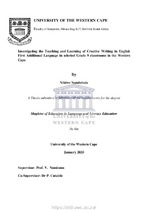| dc.contributor.advisor | Nomlomo, V. | |
| dc.contributor.author | Nondabula, Nikiwe | |
| dc.date.accessioned | 2021-07-13T10:32:51Z | |
| dc.date.available | 2021-07-13T10:32:51Z | |
| dc.date.issued | 2020 | |
| dc.identifier.uri | http://hdl.handle.net/11394/8279 | |
| dc.description | Magister Educationis - MEd | en_US |
| dc.description.abstract | Writing is an important aspect of language learning and a tool for assessment in Basic and Higher Education across the globe. Learners need to acquire proficient writing skills to learn and to demonstrate their knowledge and creativity. Given the importance of creative writing in expressing one’s thoughts, emotions and imagination, this study sought to investigate how creative writing was taught through the medium of English First Additional Language (FAL) to Grade 9 learners in one primary school in the Western Cape province. It also sought to observe and analyse the teaching strategies employed by teachers in creative writing to Grade 9 learners who were isiXhosa home language speakers, and who were taught all the subjects (except isiXhosa language) through the medium of English (FAL). Through the lens of Vygotsky’s Social Constructivism Theory, this study explored how the learners’ social context and language played a role in the teaching-learning process. The Social Constructivism theory assumes that the home environment is a primary factor in learning and it is concerned with how learning is facilitated in the classroom. This study employed a qualitative research design by making use of classroom observations, focus group interviews with randomly selected Grade 9 learners, and an interview with the Grade 9 teacher to determine how English (FAL) creative writing was taught and the barriers encountered by learners when taught writing in this language. Data was collected in a township school in Cape Town where the majority of learners were isiXhosa home language speakers. Thematic data analysis was used to make sense of the collected data. Ethical considerations were observed throughout the data collection process. One of the key findings of this study is that the Grade 9 English teacher made use of a teacher centred approach and code-switching in the teaching and learning of creative writing through the medium of English FAL. The findings also indicate that learners had limited English proficiency due to limited exposure to this language in their home environment. This study concludes that writing in English is a challenge to Grade 9 English FAL learners, and this could impede their success in other subjects across the curriculum. | en_US |
| dc.language.iso | en | en_US |
| dc.publisher | University of the Western Cape | en_US |
| dc.subject | Creative Writing | en_US |
| dc.subject | English Essays | en_US |
| dc.subject | First Additional Language (FAL) | en_US |
| dc.subject | Grade 9 | en_US |
| dc.subject | Language Barriers | en_US |
| dc.subject | Literacy Skills | en_US |
| dc.subject | Mother-tongue | en_US |
| dc.subject | Teaching Strategies | en_US |
| dc.subject | Writing | en_US |
| dc.title | Investigating the Teaching and Learning of Creative Writing in English First Additional Language in selected Grade 9 classrooms in the Western Cape | en_US |
| dc.rights.holder | University of the Western Cape | en_US |

